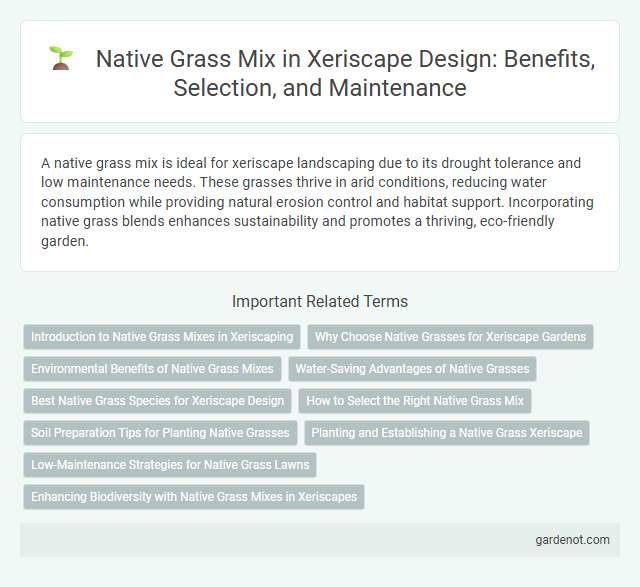A native grass mix is ideal for xeriscape landscaping due to its drought tolerance and low maintenance needs. These grasses thrive in arid conditions, reducing water consumption while providing natural erosion control and habitat support. Incorporating native grass blends enhances sustainability and promotes a thriving, eco-friendly garden.
Introduction to Native Grass Mixes in Xeriscaping
Native grass mixes in xeriscaping consist of drought-tolerant perennial grasses specifically adapted to arid environments, promoting water conservation and soil stabilization. These blends combine species such as Blue Grama, Buffalo Grass, and Needlegrass, which require minimal irrigation and maintenance while supporting local biodiversity. Incorporating native grasses enhances landscape resilience, reduces water usage by up to 50%, and creates a sustainable, eco-friendly outdoor space.
Why Choose Native Grasses for Xeriscape Gardens
Native grasses in xeriscape gardens thrive with minimal water due to their deep root systems adapted to local climates, reducing irrigation needs significantly. These grasses support local biodiversity by providing habitat for native insects and wildlife, enhancing ecosystem health. Incorporating native grass mixes promotes soil stability and reduces maintenance costs compared to non-native species in drought-prone landscapes.
Environmental Benefits of Native Grass Mixes
Native grass mixes enhance xeriscape landscapes by promoting soil stability and reducing erosion through deep root systems. These grasses require less water and fertilizer, supporting water conservation and minimizing chemical runoff into local waterways. Integrating native grass species fosters biodiversity by providing habitat and food for pollinators and wildlife, strengthening ecosystem resilience.
Water-Saving Advantages of Native Grasses
Native grass mixes significantly reduce water consumption due to their deep root systems that efficiently access underground moisture and improve soil retention. These grasses are adapted to local climate conditions, requiring minimal supplemental irrigation compared to non-native varieties. Utilizing native grass mixes in landscaping promotes sustainable water management and supports drought resilience.
Best Native Grass Species for Xeriscape Design
Buffalograss, Blue Grama, and Little Bluestem are among the best native grasses for xeriscape design due to their drought tolerance and low water requirements. These species provide excellent ground cover, erosion control, and habitat for local wildlife while reducing irrigation needs. Incorporating a native grass mix with these varieties enhances soil health and sustainability in xeriscape landscapes.
How to Select the Right Native Grass Mix
Selecting the right native grass mix requires assessing local climate, soil type, and water availability to ensure optimal growth and sustainability. Prioritize native species such as blue grama, buffalo grass, and switchgrass that thrive naturally in your region's ecosystem. Incorporating a diverse mix enhances drought tolerance, supports local wildlife, and reduces maintenance needs in xeriscape landscaping.
Soil Preparation Tips for Planting Native Grasses
Effective soil preparation for planting native grass mixes in xeriscape landscapes involves loosening the soil to a depth of 4 to 6 inches to improve aeration and root penetration. Removing weeds and incorporating organic matter such as compost enhances soil fertility and moisture retention, essential for establishing drought-tolerant native species. Ensuring proper drainage and avoiding excessive soil amendments helps maintain the natural soil structure conducive to native grass growth.
Planting and Establishing a Native Grass Xeriscape
Selecting a native grass mix suited to local climate and soil conditions is crucial for successful xeriscape planting and establishment. Prepare the soil by removing weeds and loosening the top layer to improve seed-to-soil contact, then sow seeds evenly and lightly rake to cover them. Consistent watering during the initial weeks promotes deep root development, reducing irrigation needs as the native grasses mature and adapt to xeriscape conditions.
Low-Maintenance Strategies for Native Grass Lawns
Native grass mixes tailored for xeriscape landscaping promote water conservation and reduce maintenance requirements for lawns. Selecting drought-tolerant species like buffalo grass, blue grama, and switchgrass supports resilience against heat and infrequent watering. Implementing practices such as minimal mowing, natural fertilization, and targeted irrigation enhances soil health and sustainability while preserving the ecological balance.
Enhancing Biodiversity with Native Grass Mixes in Xeriscapes
Native grass mixes in xeriscapes significantly enhance biodiversity by providing diverse habitats for local wildlife, including pollinators, birds, and beneficial insects. These grasses adapt to arid conditions, promoting soil health and reducing water consumption while supporting native ecosystems. Incorporating native grass species such as Blue Grama, Buffalo Grass, and Little Bluestem increases ecological resilience and fosters sustainable landscapes.
Native grass mix Infographic

 gardenot.com
gardenot.com